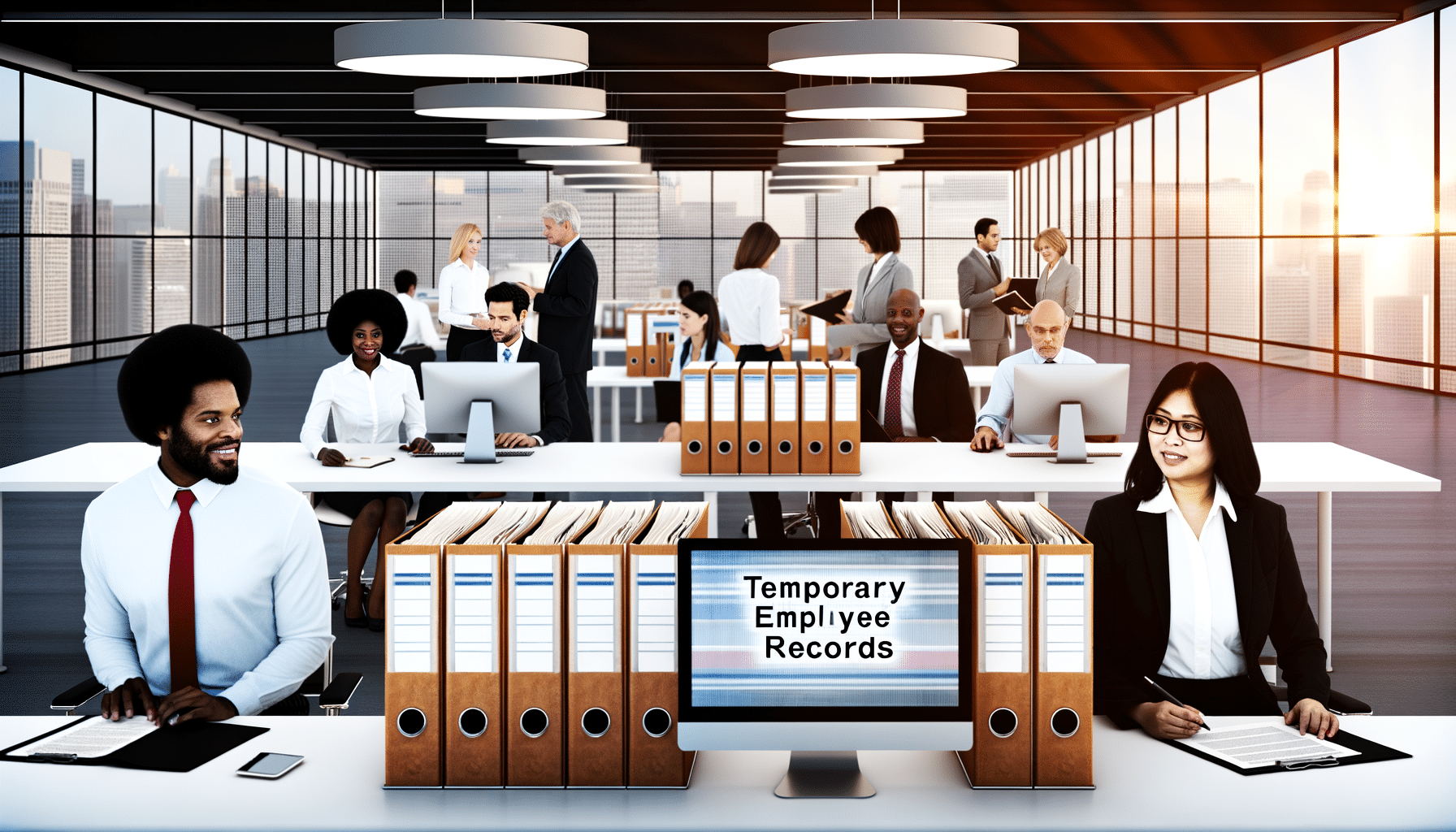- Data Synchronization
- November 17, 2024
Managing Temporary Employee Records Effectively

Introduction
Navigating the complexities of managing employee records can sometimes feel like traversing a labyrinth, especially when it comes to temporary employees. In today’s fast-paced work environment, hiring temporary staff is a necessity for many businesses seeking flexibility and agility. However, this brings its own set of challenges, particularly in organizing and maintaining accurate employee records. Here, I’ll delve into effective strategies for managing temporary employee records, drawing on my journey as an entrepreneur at the cutting edge of AI-powered record management at RecordsKeeper.AI.
The Importance of Accurate Temporary Employee Records
As tempting as it might be to view temporary employment as “temporary” even in paperwork, it is critical to maintain precise and accessible records for these roles. Not only does this ensure compliance with regulations, but it also fortifies enterprise operations by fostering organization and accountability.
Several regulations necessitate transparency and adherence to record-keeping practices, and a lapse in managing employee records appropriately can lead to costly audits or penalties. Additionally, in HR’s pursuit of excellence, having a system that harmonizes the records of both permanent and temporary employees can lead to invaluable insights and enhanced workforce planning.
Best Practices for Handling Temporary Worker Documentation
From my experience, HR departments can optimize their record management strategies by integrating advanced technologies that enhance both efficiency and security. Let’s examine some best practices that can be instrumental in managing temporary employee records effectively:
1. Embrace Digital Transformation
The manual method of storing records in physical folders is becoming increasingly obsolete. By transitioning to digital solutions like RecordsKeeper.AI, you enable automated categorization and easy retrieval of crucial employee records, including contracts, ID proofs, and performance evaluations.
- Implement AI-powered systems to categorize and tag records automatically.
- Utilize secure cloud storage for easy access and sharing.
2. Centralize Record Management
A centralized system ensures all employee records, including temporary ones, are stored securely in one place. It aids in reducing redundancy and ensures consistency in record-keeping practices across the board.
3. Adopt Robust Security Measures
Temporary employee data is as sensitive as that of any full-time employee. Implement secure data rooms that grant controlled access with real-time activity tracking, ensuring that sensitive information is shielded from unauthorized access.
4. Ensure Compliance Automation
Adhering to employment laws and industry standards like GDPR or HIPAA is non-negotiable. Utilize technology to automate compliance checks and regulatory workflows, thereby minimizing the risk of oversights and the associated penalties.
5. Conduct Regular Audits
To maintain the integrity and accuracy of all employee records, conduct regular audits. Leverage audit logs and detailed reports generated by systems like RecordsKeeper.AI to streamline this process.
The Advantage of Blockchain Integration
Blockchain technology has become a linchpin in guaranteeing the integrity and immutability of employee records. With blockchain integration, companies can achieve irreversible, tamper-proof records, providing a robust defense against fraud or data breaches. This innovation ensures that once a record is stored, it remains unchanged, offering verifiable authenticity.
How AI and Blockchain Revolutionize HR Processes
Over the years, I have witnessed firsthand how AI and blockchain technology have the potential to revolutionize HR processes. RecordsKeeper.AI, for instance, epitomizes this transformation by offering streamlined, secure, and compliant record management solutions. Our platform alleviates the administrative burden, allowing HR teams to concentrate on strategic priorities rather than time-consuming record maintenance tasks.
Conclusion
Navigating the intricacies of managing temporary employee records doesn’t have to be a daunting task. By leveraging digital transformation and advanced technologies like AI and blockchain, HR leaders can streamline processes, ensure compliance, and enhance security. The steps discussed not only alleviate the administrative load but also provide valuable insights, empowering HR departments to drive organizational success.
For more ideas on optimizing your record management strategies, stay tuned to my insights as a founder in the tech innovation space. Embrace the future of record management with RecordsKeeper.AI, where efficiency and security meet compliance.
Toshendra Sharma is the visionary founder and CEO of RecordsKeeper.AI, spearheading the fusion of AI and blockchain to redefine enterprise record management. With a groundbreaking approach to solving complex business challenges, Toshendra combines deep expertise in blockchain and artificial intelligence with an acute understanding of enterprise compliance and security needs.
Related Posts


Setting Up New Employee Record Access
Establishing record access for new staff members.
- January 2, 2025
Archives
- January 2025
- December 2024
- November 2024
- October 2024
- September 2024
- August 2024
- July 2024
- June 2024
- May 2024
- April 2024
- March 2024
- February 2024
- January 2024
- December 2023
- November 2023
- October 2023
- September 2023
- August 2023
- July 2023
- June 2023
- May 2023
- April 2023
- March 2023
- February 2023
- January 2023
- December 2022
- November 2022
- October 2022
- September 2022
Want to get more content like this?
Signup to directly get this type of content to your inbox!!
Latest Post
Document Control for Equipment Maintenance
- January 20, 2025
Managing Records for Multiple Clients
- January 19, 2025
Handling Conference Documentation
- January 18, 2025
Setting Up Department Record Reviews
- January 17, 2025





